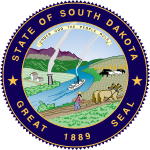
The 1889 South Dakota gubernatorial election was held on October 1, 1889, to elect the first Governor of South Dakota. Territorial Governor Arthur C. Mellette received the Republican nomination and faced former Territorial Commissioner of Immigration P. F. McClure, the Democratic nominee, in the general election. Mellette defeated McClure in a landslide.

The 1890 South Dakota gubernatorial election was held on November 4, 1890. Incumbent Republican Governor Arthur C. Mellette ran for re-election to a second term. He was challenged in the general election by State Surveyor General Maris Taylor, the Democratic nominee, and Henry A. Loucks, the President of the South Dakota Farmers' Alliance and the Independent Party nominee. In part because the left-leaning vote was split, Mellette won re-election, but by a significantly reduced margin, winning a weak plurality with just 44% of the vote. Loucks beat out Maris for second place, receiving 32% of the vote to Taylor's 24%.

The 1894 South Dakota gubernatorial election was held on November 6, 1894. Incumbent Republican Governor Charles H. Sheldon ran for re-election to a second term. Despite facing a thread of defeat at the Republican convention, Sheldon was renominated unanimously. In the general election, he faced Populist nominee Isaac Howe, a Spink County Judge; James A. Ward, the former state chairman of the South Dakota Democratic Party; and Prohibition nominee M. D. Alexander. The election was largely a replay of the gubernatorial elections of 1890 and 1892, with the Farmers' Alliance candidate placing second and the Democratic nominee placing a distant third. This time, however, Sheldon won an outright majority and the Democratic Party's vote share shrunk to just 11%, its worst performance in state history.
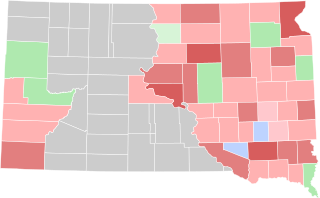
The 1892 South Dakota gubernatorial election was held on November 8, 1892. Incumbent Republican Governor Arthur C. Mellette declined to seek re-election to a third term. Former territorial legislator Charles H. Sheldon was nominated by the Republican Party as Mellette's replacement, and he faced former legislator Abraham Lincoln Van Osdel, a leader in the South Dakota Farmers' Alliance and the nominee of the Independent Party, along with Democratic nominee Peter Couchman, in the general election. The result was largely a replay of the 1890 election, with Sheldon winning by a large margin, but only a plurality, and Van Osdel taking second place over Couchman.

The 1904 South Dakota gubernatorial election was held on November 8, 1904. Incumbent Republican Governor Charles N. Herreid declined to run for re-election to a third term. Clark County State's Attorney Samuel H. Elrod won the Republican nomination to run as Herreid's successor, and he faced Democratic nominee Louis N. Crill, the former President of the State Senate, and former U.S. Congressman Freeman Knowles, the Socialist nominee. For the first time since 1894, the Democratic and Populist Parties nominated separate candidates. Ultimately, the split in the two parties did not prove dispositive; Elrod defeated Crill and the other candidates in a landslide.

The 1956 United States Senate election in South Dakota took place on November 6, 1956. Incumbent Republican Senator Francis H. Case ran for re-election to a second term. In the general election, Case was opposed by former State Representative Kenneth Holum, who was the 1954 Democratic nominee for the U.S. Senate. Owing in part to anger among the state's farmers, the race between Case and Holum was quite close, with Holum leading Case on election night and only falling behind the next day. Case ended up narrowly winning re-election, defeating Holum by just 4,620 votes.

The 1910 South Dakota gubernatorial election was held on November 8, 1910. Incumbent Republican Governor Robert S. Vessey ran for re-election to a second term. He faced two serious competitors in the Republican primary: colorful disbarred attorney George W. Egan and former Governor Samuel H. Elrod, and won the primary only with a narrow plurality. In the general election, he faced Democratic nominee Chauncey L. Wood, the Mayor of Rapid City. He improved on his margin from 1908, defeating Wood in a landslide.

The 1912 South Dakota gubernatorial election was held on November 5, 1912. Incumbent Republican Governor Robert S. Vessey declined to run for re-election to a third term. Lieutenant Governor Frank M. Byrne won the Republican primary to succeed Vessey, and then faced State Senator Edwin S. Johnson, the Democratic nominee, in the general election. Byrne only narrowly defeated Johnson, winning just 49% of the vote to Johnson's 46%, the closest gubernatorial election since 1898.

The 1950 South Dakota gubernatorial election was held on November 7, 1950. Incumbent Republican Governor George T. Mickelson was unable to seek re-election to a third term due to newly imposed term limits. Accordingly, a competitive race to replace him ensued. Attorney General Sigurd Anderson won a slim plurality in the Republican primary, barely exceeding 35% and narrowly avoiding having the Republican nomination sent to the state party convention. In the general election, Anderson faced State Representative Joe Robbie. Anderson easily defeated Robbie, winning his first term with 61% of the vote to Robbie's 39%.

The 1948 South Dakota gubernatorial election was held on November 2, 1948. Incumbent Republican Governor George T. Mickelson ran for re-election to a second term. He was opposed by Democrat Harold J. Volz, a businessman and the former Chairman of the Tripp County Democratic Party. Both Mickelson and Volz were the only candidates of their parties to file for Governor, ensuring that they won their respective nominations unopposed and removing the race from the primary ballot. In the general election, Mickelson had little difficulty defeating Volz. Though Republican presidential nominee Thomas E. Dewey only narrowly won the state over President Harry S. Truman, Mickelson's popularity allowed him to win re-election in a landslide, receiving 61% of the vote to Volz's 39%.
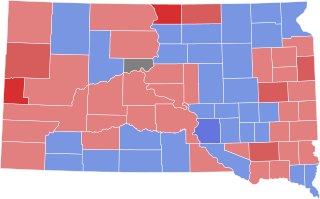
The 1938 United States Senate elections in South Dakota took place on November 8, 1938. Incumbent Republican Senator Peter Norbeck died in office on December 20, 1936. Herbert E. Hitchcock was appointed by Governor Tom Berry as Norbeck's replacement. Two elections for the same Senate seat were held on the same day; one as a special election to fill the remainder of Norbeck's six-year term, and another to select a Senator to serve the next six-year term.
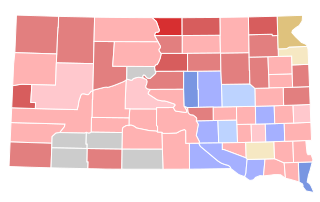
The 1922 South Dakota gubernatorial election was held on November 7, 1922. Incumbent Republican Governor William H. McMaster ran for re-election to a second term. After beating back a challenge in the Republican primary from perennial candidate George W. Egan, McMaster advanced to the general election, where he faced former State Senate President Louis N. Crill, the Democratic nominee, and suffragist Alice Lorraine Daly, the Nonpartisan League's nominee, and the first woman to run for governor. McMaster won by a large margin, but the race was considerably narrower than the 1920 election.

The 1924 South Dakota gubernatorial election was held on November 4, 1924. Incumbent Republican Governor William H. McMaster declined to run for re-election to a third term, instead opting to run for the U.S. Senate. Lieutenant Governor Carl Gunderson won the Republican primary unopposed. In the general election, he faced three prominent opponents: Democratic nominee William J. Bulow, a former State Senator and Mayor of Beresford; Farmer–Labor nominee A. L. Putnam; and perennial candidate Richard O. Richards. Gunderson. With the left-leaning vote split, Gunderson won the election in a landslide.
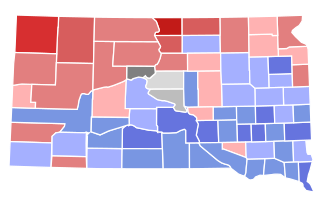
The 1926 South Dakota gubernatorial election was held on November 2, 1926. Incumbent Republican Governor Carl Gunderson ran for re-election to a second term. The election was largely a rematch of the 1924 election, with Gunderson's chief opponent from two years prior, Democrat William J. Bulow, challenging him once again. Two other candidates—Farmer–Labor nominee Tom Ayres and Pierre Mayor John E. Hipple, an independent—also ran. Though the left-leaning vote was split, Bulow was still able to win a decisive victory over Gunderson, whose support from two years earlier had completely collapsed.
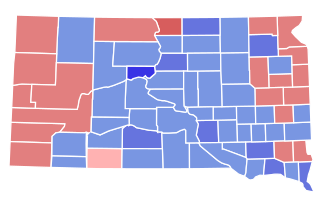
The 1928 South Dakota gubernatorial election was held on November 6, 1928. Incumbent Democratic Governor William J. Bulow ran for re-election to a second term. In the general election, he faced Attorney General Buell F. Jones, the Republican nominee. Despite Republican presidential nominee Herbert Hoover overwhelmingly defeating Democratic nominee Al Smith overwhelmingly in South Dakota, Bulow defeated Jones by a decisive margin to retain the governorship. In so doing, he became the first Democratic candidate for Governor to receive a majority of the vote in the state's history.

The 1932 South Dakota gubernatorial election was held on November 8, 1932. Incumbent Republican Governor Warren Green ran for re-election to a second term. He defeated former Governor Carl Gunderson in the Republican primary and faced former State Representative Tom Berry, the Democratic nominee, in the general election. Aided by Democratic presidential nominee Franklin D. Roosevelt's landslide victory in South Dakota, Berry defeated Green for re-election in a landslide.

The 1936 South Dakota gubernatorial election was held on November 3, 1936. Incumbent Democratic Governor Tom Berry ran for re-election to a third term, the first Governor of South Dakota to do so. Berry was challenged by Republican Leslie Jensen, the former Collector of Internal Revenue for the state of South Dakota. Both Berry and Jensen won their primaries uncontested and advanced to the general election. Some drama surrounded the potential candidacy of Democratic State Auditor George O'Neill as an independent candidate for Governor or, in the alternative, his cross-party endorsement of Jensen; after initially announcing his campaign and hedging, O'Neill dropped out of the race in September and endorsed the Democratic ticket in the state, including Berry.

The 1938 South Dakota gubernatorial election was held on November 8, 1938. Incumbent Republican Governor Leslie Jensen declined to seek re-election and instead unsuccessfully ran for the U.S. Senate. Harlan J. Bushfield, the former Chairman of the South Dakota Republican Party, won the Republican primary to succeed Jensen. In the general election, he faced Democratic nominee Oscar Fosheim, a State Representative from Miner County, in the general election. Bushfield defeated Fosheim by a relatively close margin, winning his first term as governor.

The 1940 South Dakota gubernatorial election was held on November 5, 1940. Incumbent Republican Governor Harlan J. Bushfield sought re-election to a second term. After winning the Republican primary by a large margin, he faced Democrat Lewis W. Bicknell, former Day County State's Attorney, in the general election. Though Bushfield underperformed Republican presidential nominee Wendell Willkie, who won the state in a landslide, he nonetheless defeated Bicknell by a wide margin to easily win re-election.

The 1942 South Dakota gubernatorial election was held on November 3, 1942. Incumbent Republican Governor Harlan J. Bushfield declined to seek re-election to a third term and instead successfully ran for the U.S. Senate. A crowded Republican primary developed to succeed him, and because no candidate received 35% of the vote, the nomination was decided at the state Republican convention, where former Attorney General Merrell Q. Sharpe, the second-place finisher in the primary, won the nomination. In the general election, Sharpe faced Democratic nominee Lewis W. Bicknell, the 1940 Democratic nominee for Governor. Aided by the national Republican landslide, Sharpe defeated Bicknell in a landslide.

